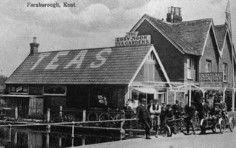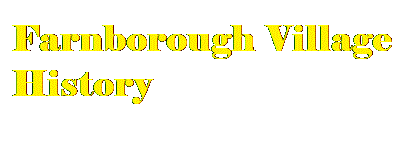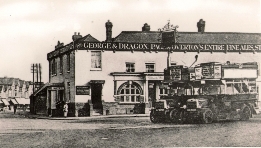


FARNBOROUGH LODGE
'Damn these pirates of the road,' thundered Sir Robert Peel in 1840 when he heard how a coach had been ambushed by a highwayman who had snatched a gentleman by the name of John Evelyn, robbed him, and left him tied to a tree in a lane by High Elms.
Widow Smith's coaches travelled regularly from Smithfield to Dover, stopping at The George and Dragon and Change of Horses Inns in Farnborough. They were maintained at a wheelwright's at Pratts Bottom, where the wheels and running gear would be checked and the hubs oiled.
|
Sir Robert, when he was Secretary of State for Ireland, had started
a police force there where they were called 'bobbies'. In 1829 he inaugurated a police force for London, known as 'peelers'. When he heard about the incident at High Elms he decided that such people should be protected and opened a police station at Locksbottom (only lately closed down) where he lived for a time, putting his sister and her husband into an old farm then called Chalk Farm. This large Elizabethan building standing in 72 acres of land was later Fern Lodge. Farnborough's original name in 862 was Farnbiorginga meaning 'fern growing' — hence no doubt the name. Fern Lodge eventually became Farnborough Lodge, probably in 1840 when a facade in the Georgian style was added. |

At the back of the Lodge in 1940. note the sandbags. |
The extensive grounds had many beautiful trees and included a coach house, stables, a sunken garden, vegetable garden with a melon house (oh those little nets), two heated greenhouses, an orchard and an asparagus bed.
In 1924 Ernest Selby rented it with three acres of land for £150 a year from Eric Rogers who at about this time had bought the properties now called Keston and Farnborough Parks. His father had seen the development of such woodlands in America with their many different houses built among the trees, which had greatly impressed him.
Mr Selby had bought another large house called Topcliffe Grange, situated on the road between Farnborough Hospital and Green Street Green, for his daughter's wedding present. His wife had died in the Spanish influenza epidemic of 1918. In 1924 he moved into the Lodge with his young second wife. They had children, Isobel and James, who grew up in this lovely old house. The Elizabethan part was warm red brick, the later addition white with a pillared entrance, all covered with ivy and virginia creeper. The house had many rooms, divided by lath or daub-and-plaster walls behind which the son and daughter remember lots of mice scuttling. The dining room had oak linen-fold panelling, with blue and white delft tiles round the fireplace. The kitchen had huge walk-in larders and great stone flags on the floor. There were hooks in the beamed ceiling where bacon and onions would have been hung. Part of the cellars were twelfth century.
All the time the Selbys lived there, there was no electricity — instead, gas lighting, a coke boiler to heat the water and greenhouses, and coal fires in all the rooms. In the grounds was a cottage for the chauffeur, Wilding, and the cook when he married her. After Ernest Selby died in 1940, Mrs Selby accommodated medical students for the duration of the war.
The family left the Lodge in 1948. It was then given for his lifetime to Robert Elliot, a faith healer, by Eric Rogers — whose child, it was said, had been healed of polio by him. He lived there employing two ladies — Wynne, a little round one, and her sister-in-law, who was tall and pretty. Wynne managed the house while the other one looked after the garden with its flowers and vegetables.
It was at this time that I came into contact with the Lodge. In 1935 when Halvard and I were married we lived in another lovely old mansion in Wimbledon called Atherton Grange. I remember mostly its high galleried hall and very large kitchen. It belonged to the Beltane School, where I was teaching, and was sometimes occupied by a few pupils and at the top of the house by the driver of the school car, his wife and daughter. In the following February, when I was pregnant, we had to look for a home of our own. It was then that we came across a vacant woodland plot in Farnborough Park, where we had our small cottage built.
After the war, settled once more in The Glen after having to move away at times of danger, we used to pass the back gate of the Lodge in Elm Walk. Often we would buy flowers and vegetables there and I became quite friendly with the tall lady who would sometimes let me have a peep into the house, but am now in touch with Jeannie Butt, a faith healer who was healed by Elliot and worked with him. She says, 'I would love to see it again. It had a wonderful atmosphere of peace and tranquillity.'
Mr Elliot died suddenly in 1960 leaving his helpers unprovided for. Mr Rogers let Wynne live in the Lodge free of charge for two years, but when he died in 1970, his wife was obliged to sell the property to pay death duties. It was eventually bought by a builder who went in for buying old houses, demolishing them and building new ones on the site. This time the plan did not work out as he hoped. He found it was a listed building, so for some time it remained empty, deteriorating still further.
 |
 |
| September 1927: Beth, Jinny, Isobel, James and Charmian at the back of Fern Lodge. | The sunken garden behind the Lodge — Jim on wall, Isobel in background. Picture taken in 1929. |
Then in 1984 the McGraths found it (with a hundred resident pigeons who paid no rent!), realised its potential and that it was just what they wanted. A few Sundays ago I wa} allowed to take James Selby, his wife and his sister Isobel to see the house, where we spent two hours. How kind of them to give us this opportunity and their time. How thrilled the Selbys were to see the home where they had lived 45 years ago, their bedrooms and all their secret places.
The McGraths have made a grand job of it, although beset by many difficulties. Some parts had to be pulled down as they were dangerous, but English Heritage and the Council were very strict about as much as possible being preserved, as indeed were the McGraths about preserving its character.
 |
 |
| The new front of Farnborough Lodge with Jim Selby and Mr McGrath. | The original front of Farnborough Lodge, 1991. |
When the Selbys saw it, they were not disappointed or unhappy to see the changes. In fact they felt any changes were an improvement. I do not think they had realised the beauty of the old red brickwork which had once been hidden by foliage.
Muriel Prynne



